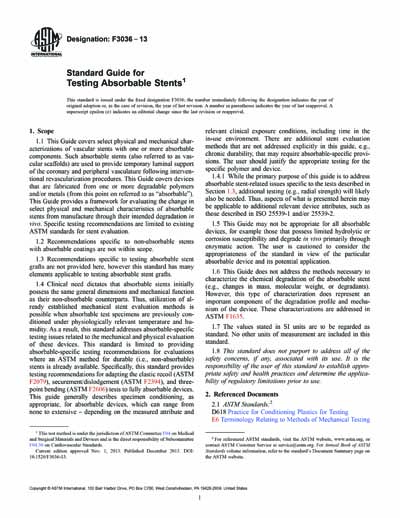Historical
ASTM F3036-13
Standard Guide for Testing Absorbable Stents
1.1 This Guide covers select physical and mechanical characterizations of vascular stents with one or more absorbable components. Such absorbable stents (also referred to as vascular scaffolds) are used to provide temporary luminal support of the coronary and peripheral vasculature following interventional revascularization procedures. This Guide covers devices that are fabricated from one or more degradable polymers and/or metals (from this point on referred to as “absorbable”). This Guide provides a framework for evaluating the change in select physical and mechanical characteristics of absorbable stents from manufacture through their intended degradation in vivo. Specific testing recommendations are limited to existing ASTM standards for stent evaluation.
1.2 Recommendations specific to non-absorbable stents with absorbable coatings are not within scope.
1.3 Recommendations specific to testing absorbable stent grafts are not provided here, however this standard has many elements applicable to testing absorbable stent grafts.
1.4 Clinical need dictates that absorbable stents initially possess the same general dimensions and mechanical function as their non-absorbable counterparts. Thus, utilization of already established mechanical stent evaluation methods is possible when absorbable test specimens are previously conditioned under physiologically relevant temperature and humidity. As a result, this standard addresses absorbable-specific testing issues related to the mechanical and physical evaluation of these devices. This standard is limited to providing absorbable-specific testing recommendations for evaluations where an ASTM method for durable (i.e., non-absorbable) stents is already available. Specifically, this standard provides testing recommendations for adapting the elastic recoil (ASTM F2079), securement/dislodgement (ASTM F2394), and three-point bending (ASTM F2606) tests to fully absorbable devices. This guide generally describes specimen conditioning, as appropriate, for absorbable devices, which can range from none to extensive – depending on the measured attribute and relevant clinical exposure conditions, including time in the in-use environment. There are additional stent evaluation methods that are not addressed explicitly in this guide, e.g., chronic durability, that may require absorbable-specific provisions. The user should justify the appropriate testing for the specific polymer and device.
1.4.1 While the primary purpose of this guide is to address absorbable stent-related issues specific to the tests described in Section 1.3, additional testing (e.g., radial strength) will likely also be needed. Thus, aspects of what is presented herein may be applicable to additional relevant device attributes, such as those described in ISO 25539-1 and/or 25539-2.
1.5 This Guide may not be appropriate for all absorbable devices, for example those that possess limited hydrolytic or corrosion susceptibility and degrade in vivo primarily through enzymatic action. The user is cautioned to consider the appropriateness of the standard in view of the particular absorbable device and its potential application.
Content Provider
ASTM International [astm]






